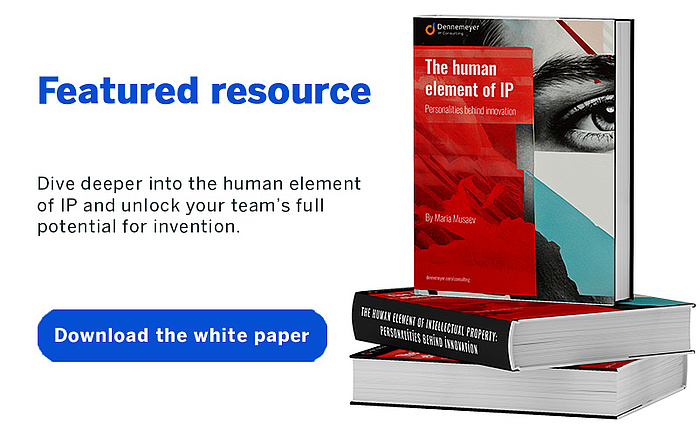
The human element of Intellectual Property: personalities behind innovation
The intersection of personality and Intellectual Property (IP) is often overlooked, yet it has a powerful influence over how inventors and IP professionals engage with the patent process. Recognizing these dynamics and understanding their effects can lead to closer collaboration and better utilization of IP protections, ultimately fostering innovation.
We have a white paper that offers valuable insights and actionable strategies to harness the diverse strengths of creative minds, improve their collaboration and push forward groundbreaking advancements. Though the emotions and psychology behind patents are the least qualifiable aspects of the process, they can be demystified, becoming an even greater source of confidence.

The inventor's paradox
Inventors frequently encounter a contradiction where they simultaneously recognize the benefits of patent protection but harbor negative feelings toward the application process. This discord stems from the complexities and perceived bureaucratic nature of securing IP rights. With its long wait times and stringent examinations, many inventors and researchers may feel overwhelmed or disengaged from the procedure despite patents' clear advantages in safeguarding their innovations.
Personality research, particularly within organizational psychology, has shown that certain traits can significantly influence job performance and professional interactions. The DiSC model, which categorizes behavioral patterns into Dominance, inducement (influence), Submission (Steadiness) and Compliance, serves as a useful tool for understanding these characteristics in the context of innovation and technology.
The "C"-type personality, known for its meticulous and task-oriented nature, is often prevalent among inventors, engineers and scientists. These individuals thrive on precision and structure, which aligns well with the intricate and procedural aspects of securing patents. However, the innovation ecosystem includes all personality types, each bringing their aptitudes and dilemmas to the table. For instance, the "D" type, with its assertive and results-driven approach, can push projects forward rapidly but may overlook crucial points, while the "i" type, which thrives on social interaction, can promote cooperative environments but might struggle with the precision demanded by patent documentation.
Challenges in the patent system
One major issue with the current patent system is its elaborateness and reliance on abstruse legal language, which can alienate inventors and R&D teams. This lack of transparency can lead to decreased communication between developers and legal specialists, fomenting resentment toward the patent process itself. Small and medium-sized enterprises (SMEs), in particular, find it difficult to navigate these hurdles effectively without internal patent experts.

Although straightforward in theory, the patent process can be intellectually demanding and emotionally draining for those not used to its highly involved steps. Reflecting on how individuals respond to these stresses is essential to promoting engagement with the IP system.
Moreover, the time-consuming nature of patent applications can deter innovators who are eager to see their ideas come to life quickly. The lengthy approval process, coupled with the costs associated with securing a patent, can be particularly burdensome for startups and smaller firms.
Leveraging personality strengths for better collaboration
To address these issues, it is essential to harness different personality types' faculties and working styles. Companies can create a more robust and inclusive IP framework by organizing patent processes around the painstaking and structured "C"-type personality. This approach streamlines workflows and lends the appropriate weight to the need for order and accuracy.
At the same time, other behavioral archetypes can contribute in a way that complements rather than clashes with fastidious employees. For example, pairing a "C" individual, who excels at detailed work, with an "i" type, who brings creativity and social skills into play, can result in a well-rounded team capable of both rigorous documentation and innovative idea generation. Similarly, the "D" personality can bring momentum to projects, ensuring milestones are met, while the "S" type, known for its supportive and steady nature, can maintain team cohesion and manage stress levels.
Implementing IP-centric practices
There is a variety of steps organizations can take to enhance collaboration and improve the patenting experience:
- IP basic training: This instruction should provide relevant and practical information in a digestible format, ensuring that everyone can grasp the IP fundamentals. Such training could cover the steps involved in securing patents and common pitfalls to avoid.
- Invention harvesting workshops: These workshops bring together cross-functional teams, offering a space for inspiration and coordination in the patent-creation process. By encouraging open dialogue and idea-sharing, innovations can be identified and protected more efficiently.
- Accessible IP databases and patent search tools: Software and tools should be designed to cater to different personality types, making data interpretation straightforward and accessible for all. User-friendly interfaces and comprehensive search functionalities can help clarify the patent landscape, enabling inventors and legal teams to work more effectively together.

No single innovator is equally skilled in all aspects of IP generation, yet these gaps are not flaws to be pasted over but rather an opening for dialogue with someone of another personality type. Working together, creative minds have the chance to achieve more.
The role of personality in innovation
The human behind IP is a critical factor that can significantly impact the success of innovation and the patenting process. Organizations can nurture a more effective, shared IP space by acknowledging and accommodating various personality types.
As we move forward in an increasingly complicated and competitive landscape, embracing the personalities behind innovation will unlock the full potential of inventions. By recognizing these dynamics and implementing strategies to support people, we pave the way for a more inclusive, efficient and successful approach to patents.
Filed in

Market downturns are painful, but as a category of intangible assets, IP is less susceptible to these kinds of fluctuations and can offer much-needed stability.

Explore 10 tips designed to help every new IP counsel create both personal and organizational success.



